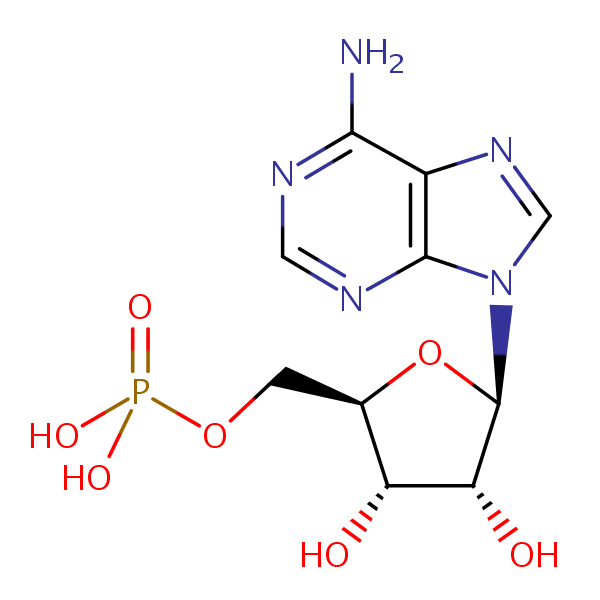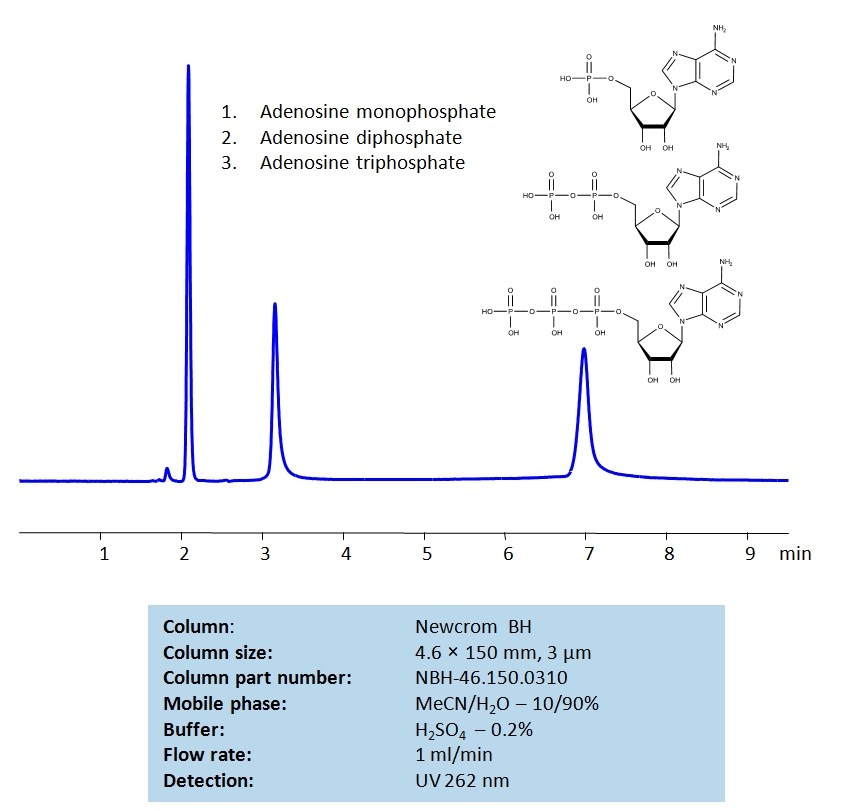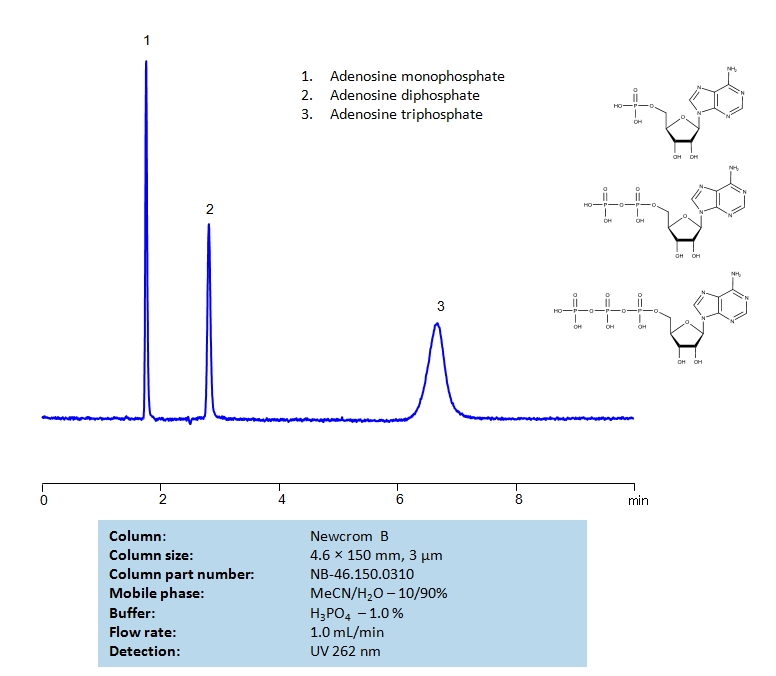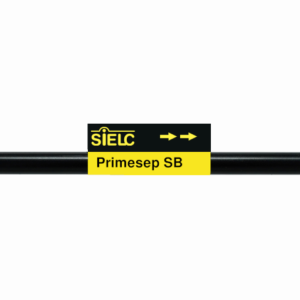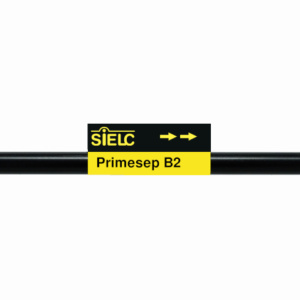| CAS Number | 61-19-8 |
|---|---|
| Molecular Formula | C10H14N5O7P |
| Molecular Weight | 347.224 |
| InChI Key | UDMBCSSLTHHNCD-KQYNXXCUSA-N |
| LogP | -1.78 |
| Synonyms |
|
Applications:
HPLC Separation of Adenosine mono-, di- and triphosphates on Newcrom BH Column
May 11, 2021
HPLC Method for Adenosine Monophosphate, Adenosine Diphosphate, Adenosine Triphosphate on Newcrom BH by SIELC Technologies
High Performance Liquid Chromatography (HPLC) Method for Analysis of Adenosine Monophosphate, Adenosine Diphosphate, Adenosine Triphosphate
Adenosine Triphosphate (ATP) is a nucleotide with the chemical formula C10H16N5O13P3. It is a primary energy carrier of the cell and is crucial to cellular energy metabolism. ATP is generated in the mitochondria and is used in numerous various cellular processes. It releases energy when a phosphate linkage breaks from it, creating adenosine diphosphate.
Adenosine Diphosphate (ADP), also known as adenosine pyrophosphate, is a compound with the formula C10H15N5O10P2. It is a precursor in the synthesis of DNA and RNA. Medications that block ADP receptors on platelets prevent blood clots in conditions like heart attacks and strokes.
Adenosine Monophosphate (AMP) is a nucleotide with the chemical formula C10H14N5O7P. Due to being a byproduct of ATP and ADP, it can be reused by the body for energy at higher forms. AMP can be converted into cyclic adenosine monophosphate (cAMP) to become a second messenger in the body, relaying signals between cells.
Using a Newcrom BH mixed-mode column and a mobile phase consisting of water and acetonitrile with a sulfuric acid (H2SO4) buffer, adenosine mono-, di- and triphosphate can be separated, measured, and analyzed. This method can UV detect this family of compounds at 262 nm with very high resolution.
| Column | Newcrom BH, 4.6 x 150 mm, 3 µm, 100 A, dual ended |
| Mobile Phase | MeCN/H2O – 10/90% |
| Buffer | H2SO4 – 0.2% |
| Flow Rate | 1.0 ml/min |
| Detection | UV 262nm |
| Class of Compounds | Acid, Hydrophilic |
| Analyzing Compounds | Adenosine Monophosphate, Adenosine Diphosphate, Adenosine Triphosphate |
Application Column
Newcrom BH
Column Diameter: 4.6 mm
Column Length: 150 mm
Particle Size: 3 µm
Pore Size: 100 A
Column options: dual ended
Adenosine Monophosphate
Adenosine Triphosphate

HPLC Separation of Adenosine Mono-, Di- and Triphosphate on Newcrom B column
April 13, 2020
P HPLC Method for Adenosine Diphosphate, Adenosine Monophosphate, Adenosine Triphosphate on Newcrom B by SIELC Technologies
High Performance Liquid Chromatography (HPLC) Method for Analysis of Adenosine Diphosphate, Adenosine Monophosphate, Adenosine Triphosphate.
Adenosine Triphosphate (ATP) is a nucleotide with the chemical formula C10H16N5O13P3. It is a primary energy carrier of the cell and is crucial to cellular energy metabolism. ATP is generated in the mitochondria and is used in numerous various cellular processes. It releases energy when a phosphate linkage breaks from it, creating adenosine diphosphate.
Adenosine Diphosphate (ADP), also known as adenosine pyrophosphate, is a compound with the formula C10H15N5O10P2. It is a precursor in the synthesis of DNA and RNA. Medications that block ADP receptors on platelets prevent blood clots in conditions like heart attacks and strokes.
Adenosine Monophosphate (AMP) is a nucleotide with the chemical formula C10H14N5O7P. Due to being a byproduct of ATP and ADP, it can be reused by the body for energy at higher forms. AMP can be converted into cyclic adenosine monophosphate (cAMP) to become a second messenger in the body, relaying signals between cells.
Adenosine Diphosphate, Adenosine Monophosphate, Adenosine Triphosphate can be retained and analyzed using the Newcrom B stationary phase column. The analysis utilizes an isocratic method with a simple mobile phase consisting of water and acetonitrile (MeCN) with a Sulfuric Acid buffer. Detection is performed using UV.
| Column | Newcrom B, 4.6 x 150 mm, 3 µm, 100 A, dual ended |
| Mobile Phase | MeCN/H2O – 10/90% |
| Buffer | H2SO4 – 1.0% |
| Flow Rate | 1.0 ml/min |
| Detection | UV 262nm |
| Class of Compounds | Acid, Hydrophilic |
| Analyzing Compounds | Adenosine Diphosphate, Adenosine Monophosphate, Adenosine Triphosphate |
Application Column
Newcrom B
Column Diameter: 4.6 mm
Column Length: 150 mm
Particle Size: 3 µm
Pore Size: 100 A
Column options: dual ended
Adenosine Monophosphate
Adenosine Triphosphate

Separation of Nucleotide Monophosphates
July 13, 2015
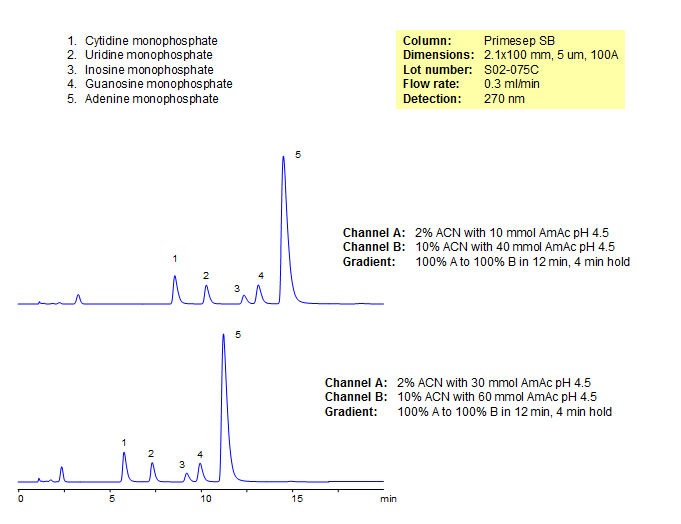
Nucleotides are the monomers of DNA and RNA, composed of a five-carbon sugar, a nitrogenous base, and at least one phosphate group. Primesep SB is a good column for separating these highly polar compounds. Primesep SB is a reverse-phase column with strong embedded basic ion-pairing groups. Retention can me manipulated by adjusting acetonitrile, and the baseline separation can be achieved in under 6 minutes using a gradient.
Application Column
Primesep SB
The Primesep family of mixed-mode columns offers a wide variety of stationary phases, boasting unprecedented selectivity in the separation of a broad array of chemical compounds across multiple applications. Corresponding Primesep guard columns, available with all stationary phases, do not require holders. SIELC provides a method development service available to all customers. Inquire about our specially-tailored custom LC-phases for specific separations.
Select optionsCytidine Monophosphate
Guanosine Monophosphate
Inosine Monophosphate
Uridine Monophosphate

Separation of Nine Nucleotides by Mixed-Mode Chromatography
July 6, 2015
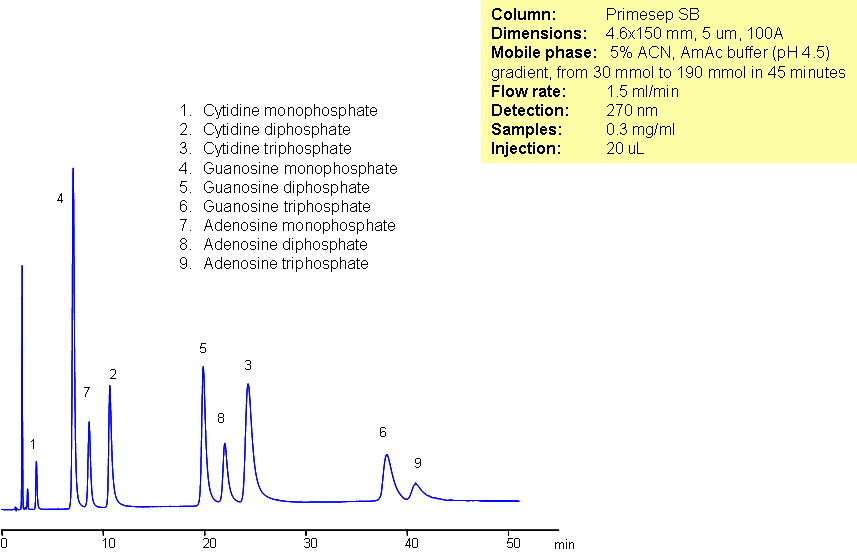
Nucleotides are important biological molecules which serve as subunits of nucleic acids. They are composed of a five-carbon sugar, a nitrogenous base, and at least one phosphate group. Nucleotides cannot be retained by reverse-phase chromatography without an ion-pairing reagent due to their highly polar nature. Primesep SB is capable of retaining and separating nine nucleotides. Primesep SB is a reverse-phase column with strong embedded basic ion-pairing groups.
Application Column
Primesep SB
The Primesep family of mixed-mode columns offers a wide variety of stationary phases, boasting unprecedented selectivity in the separation of a broad array of chemical compounds across multiple applications. Corresponding Primesep guard columns, available with all stationary phases, do not require holders. SIELC provides a method development service available to all customers. Inquire about our specially-tailored custom LC-phases for specific separations.
Select optionsAdenosine Monophosphate
Adenosine Triphosphate
Cytidine Diphosphate
Cytidine Monophosphate
Cytidine Triphosphate
Guanosine Diphosphate
Guanosine Monophosphate
Guanosine Triphosphate

Separation of Nicotinamide and Related Substances
May 11, 2015
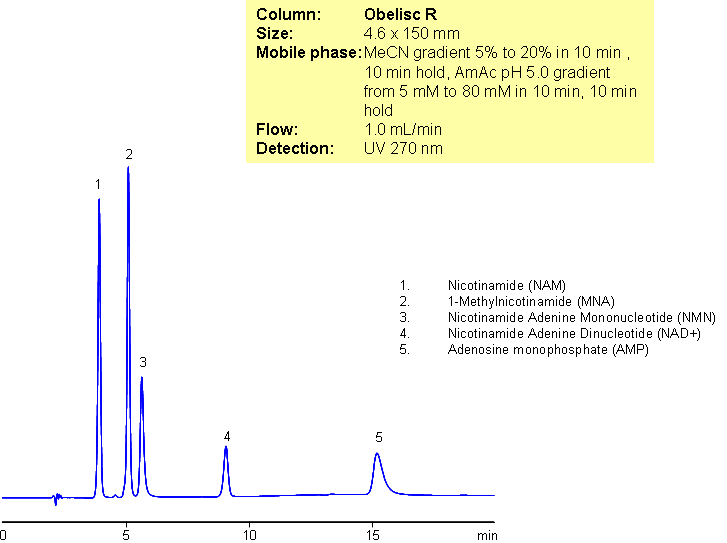
A complex mixture of nicotinamide and related impurities was separated on Obelisc R mixed-mode column. Nicotinamide, methylnicotinamide, nicotinamide adenine mononucleotide, nicotinamide adenine dinucleotide, and adenosine monophosphate were baseline resolved in a 15 minute long method. This mixed-mode approach can be used for analysis of other nucleotides. Obelisc R trimodal column separates this complex mixture based on reversed-phase, cation-exchange and anion-exchange mechanisms. Retention is controlled by amount of ACN, buffer concentration and buffer pH. Additional selectivity can be gained by exploring various buffers within the same pH
Application Column
Obelisc R
SIELC has developed the Obelisc™ columns, which are mixed-mode and utilize Liquid Separation Cell technology (LiSC™). These cost-effective columns are the first of their kind to be commercially available and can replace multiple HPLC columns, including reversed-phase (RP), AQ-type reversed-phase, polar-embedded group RP columns, normal-phase, cation-exchange, anion-exchange, ion-exclusion, and HILIC (Hydrophilic Interaction Liquid Chromatography) columns. By controlling just three orthogonal method parameters - buffer concentration, buffer pH, and organic modifier concentration - users can adjust the column properties with pinpoint precision to separate complex mixtures.
Select optionsAdenosine Monophosphate
Nicotinamide
Nicotinamide Adenine Dinucleotide (NAD)
Nicotinamide Adenine Mononucleotide
UV Detection

HPLC Separation of Adenosine Mono-, Di- and Triphosphate in Reversed-Phase Mixed-Mode with LC/MS Compatible Conditions
December 5, 2013
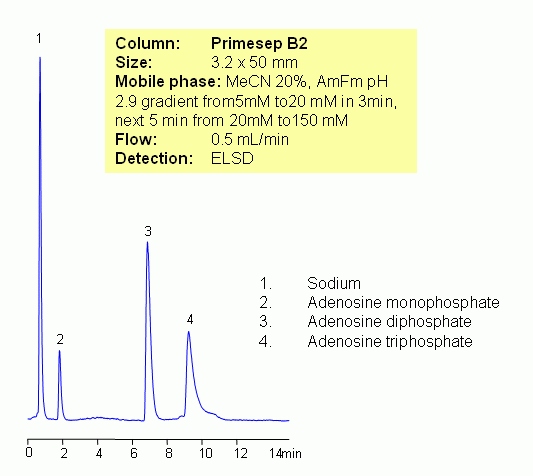
Adenosine mono-, di and triphosphate are hydrophilic nucleotides which serve as building blocks of DNA and RNA. Each molecule consists of phosphate or phosphate groups, adenine and sugar ribose. Molecules are hydrophilic and lack a retention mechanism on traditional reversed-phase column. Three nucleotides were retained and separated on Primesep B2 reversed-phase anion-exchange column. retention time is controlled by buffer concentration and buffer pH. ADP and ATP require higher concentration of buffer to facilitate elution. Method can be used for LC/MS analysis of different nucleotides in various sample matrices (biofluids, plasma, blood, urine). Other detection techniques can be used for analysis. Method is reliable and robust and can tolerate interference from sample matrix. Additional sample preparation might be required.
| Column | Primesep B2, 3.2×50 mm, 5 µm, 100A |
| Mobile Phase | MeCN/H2O – 20/80% |
| Buffer | AmFm pH 2.9- 5-20 mM 3 min, 20-150 mM |
| Flow Rate | 0.5 ml/min |
| Detection | ELSD |
| Class of Compounds |
Nucleotide, Hydrophilic, Ionizable |
| Analyzing Compounds | Adenosine Monophosphate, Adenosine Diphosphate, Adenosine Triphosphate |
Application Column
Primesep B2
The Primesep family of mixed-mode columns offers a wide variety of stationary phases, boasting unprecedented selectivity in the separation of a broad array of chemical compounds across multiple applications. Corresponding Primesep guard columns, available with all stationary phases, do not require holders. SIELC provides a method development service available to all customers. Inquire about our specially-tailored custom LC-phases for specific separations.
Select optionsAdenosine Monophosphate
Adenosine Triphosphate

